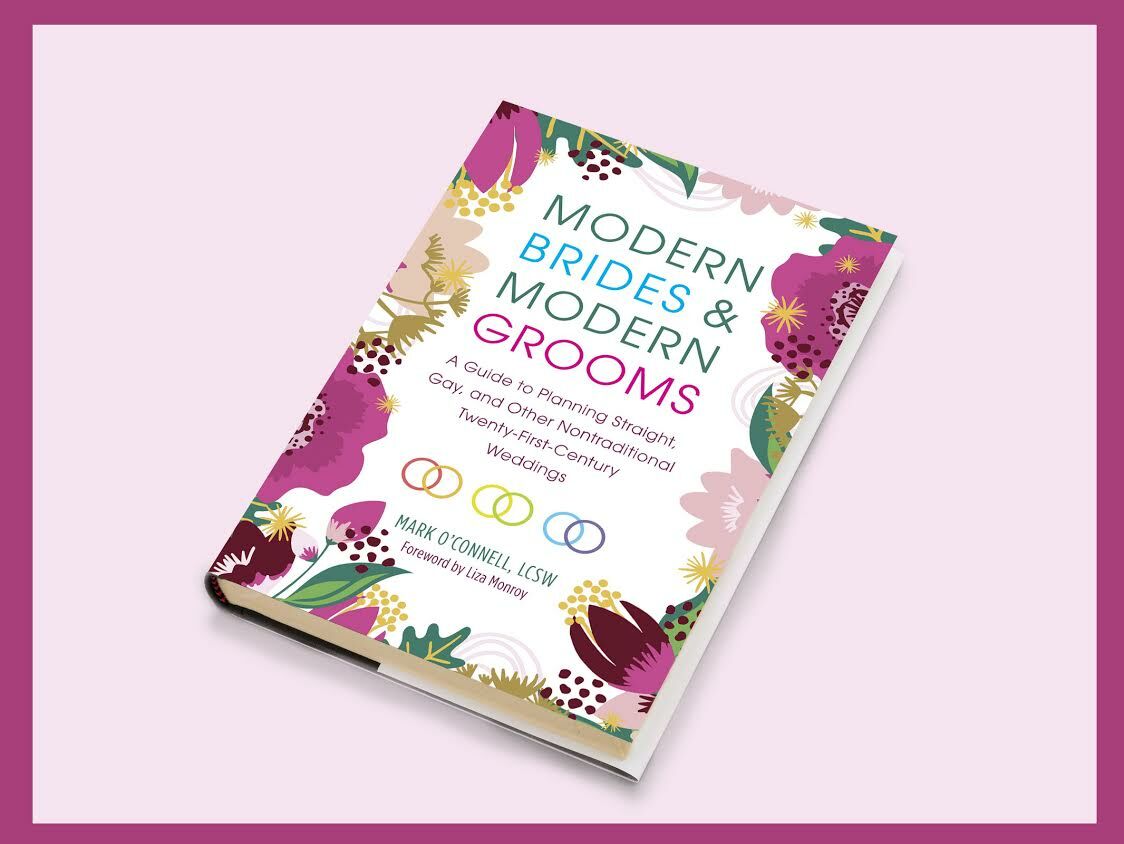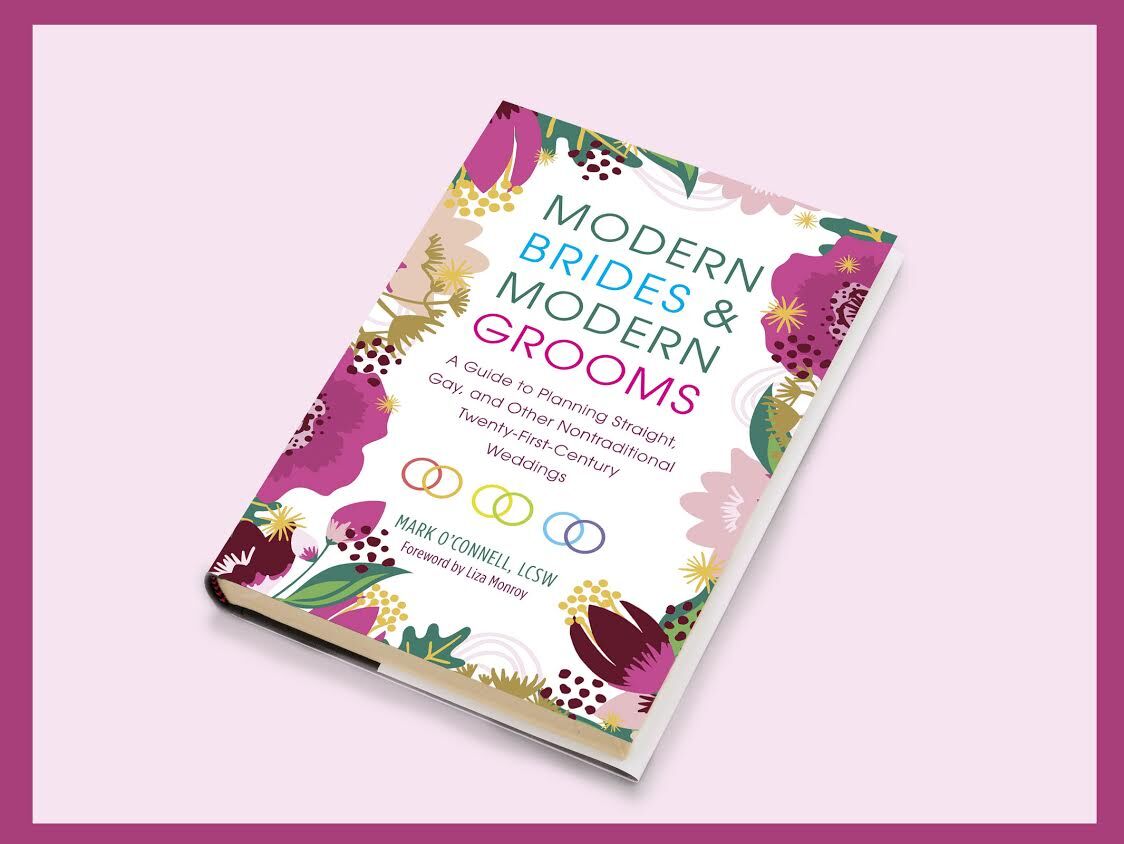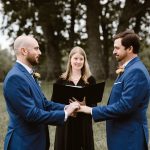
Planning a Same-Sex Wedding and Getting Unsolicited Advice From Relatives?
Mark O’Connell, author of Modern Brides & Modern Grooms: A Guide to Planning Straight, Gay, and Other Nontraditional Twenty-First-Century Weddings, shares an excerpt from his book about how to deal with wedding advice from traditional relatives.
by Ivy Jacobson

Spotlights Behind the Curtain: Queer Tips From Traditional Relatives
“Are you gonna wear a duct tape bridal gown?” I queried Justin’s cousin Emily.
I’ll have you know that Emily’s mom, Aunt Corky, is the first to ever make a dress entirely out of duct tape! She designed it for Emily’s prom back in the nineties. Emily’s picture showed up in big magazines—like Maxim—and the trend went viral. The duct tape dress has become a phenomenon, a thing. It’s now an ongoing contest and was even a design challenge on Project Runway in 2012. But to this day, Corky has taken no formal credit; they’re private people. Which is why I asked provokingly about Emily’s wedding attire—she was very-long engaged to her fiancé, but with no nuptials in sight. I wanted everyone involved to have the attention I felt they deserved. I wanted their queer truth—which had been obscured by normalcy/”privacy”—to make the headlines.
You see, wherever there’s queerness, there’s truth. Wherever there’s queerness, there’s need.
Many if not most of our modern weddings—be they gay, straight, or what have you—are queer, meaning they resist category or definition. I guarantee you are currently after such a nuptial yourself, one in which your truth outweighs tradition. That which is queer about you needs to deviate from the norm to exist, to live, to breathe—the way Emily needed a duct tape dress to feel like herself at prom.
Lyn and Jorge
My friend Lyn’s wedding is a great example of queer = truth = need. Lyn was raised Jewish and only dated Jewish guys until she met Jorge—a non-practicing Catholic of Salvadoran descent. So, not Jewish. Conservative (and brittle) in his Judaism, Lyn’s brother adamantly shared with Lyn prior to her wedding his strong belief that she should be married within the faith. To avoid further conflict, Lyn did not mention that a female rabbi would perform their ceremony, not wanting to hear more criticism. Her brother initially refused to attend. Meanwhile, Lyn’s father—a natural born Jew cum Catholic deacon—had ruffled feathers that Jorge wasn’t more Catholic. Her dad was also careful not to get too close to their chuppah during the service.
Lyn was aggrieved by all of this, for a time. Every choice she made induced holy wars. But when she became too tired to care, she reminded herself why she wanted a wedding in the first place. She loves Jorge. She wants to spend the rest of her life with him. And she wanted to celebrate that with the most important people in her life. Provokingly queer as her wedding seemed to some, that was not Lyn’s intention. Her lovely wedding was simply the outcome of her truth and her need leading the way, and though it has taken time, her brother now has a warm relationship with Jorge, and is expressive about his abundant love for Lyn and Jorge’s son.
Your Reveal
So don’t worry about being provocative as long as you’re being you. The Batman and Robin wedding, or the Black Swan, Steam Punk, Alien vs. Predator, or Star Wars wedding—complete with processional to the Darth Vader March—can certainly all work, but only if the concept reveals you. Not if it shrouds you in extraneous camp. It can be tricky to tell the difference, especially when the normative police surround us in the form of our family and friends, and especially when the normative police are also us.
The Normative Police
The siren of the normative police goes off in a number of ways—Lyn’s brother’s crude approach, of course, but also by modes more subtle. My mother fearing we’d have an Elton John Wedding or people asking things like “You’re not covering your tattoos?” or “You don’t need to kiss at the altar, right? Since you’re two guys?” Friends calling you Bridezilla or Groomzilla just because you want a shimmery dress or suit that makes you feel like a star. Family saying you’re “too much,” just because you’re actually excited to get married or because you actually want to be seen in this light. It’s so easy to be discouraged at these times, to closet your excitement and/or to wilt in shame.
Take some time to reflect on messages that restrain you from basking in the spotlight—especially when you’re the one policing yourself.
Look long and hard at the ways you dream of showing off. Do these images give you chills? If so, maybe that’s because the idea of celebrating everything you love in front of the people you love thrills you. Even if your choice of presentation seems provocative to some, provocation might not be your end goal. Even if you choose to tear down the walls of tradition—the way Lyn did in marrying a non-Jew and having a female rabbi—perhaps you’ve done this to create space for your truth to exist. Not merely to “make a scene.”
Moreover, maybe your traditional-seeming relatives have more queer wisdom to offer you than initially meets the eye.
For example, I once mistook Aunt Corky for being the normative police during a visit with her and her husband, Uncle John, shortly after our wedding. Corky didn’t like one of the toasts at our reception, and she wanted us to know it. “I just didn’t think it was necessary,” she said, referring to the “political” toast given by our dear friend Sharon. Sharon’s an intensely gregarious, fiercely articulate force—we sometimes call her Hurricane Sharon. She was kicking butt as an attorney for the ACLU LGBT project at the time of our nuptials, and with the fault lines of marriage shifting—legally and socially—we could think of no one better for the keepin’-it-real, advocacy portion of our illegal wedding than her. But Corky did not agree. “We were obviously all there to support you. Why did anyone need to go there?”
Her comments made me bristle at the time, but I short-sightedly, and innacurately, chalked them up to her being traditional.
Justin’s mother, Sandy, had perhaps colored my view, suggesting that John (her brother) was considered to be “normal” by their WASPy parents, while Sandy felt like the black sheep. John and Corky had a healthy long marriage, a beautiful New England farmhouse—with a picket-fence—and two lovely daughters. While Sandy—though she had two lovely sons—was divorced and extremely unconventional in humor, in style, and in general. But this is just one perspective.
Look out for biased family narratives. They can create unnecessary obstacles between you and some of your relatives.
Sure, from the helicopter view, John and Corky may resemble the normal family from Leave it to Beaver, but if you zoom in on the lizard tattoo on Corky’s ear, you’ll see a fabulous queerness wiggling its way out. In fact, if you go to their house—which resembles a gorgeous, New England bed and breakfast—you may notice a magical light escaping from a door upstairs. That’s Corky’s craft room. Inside, you’ll find hand-painted toys, chairs, clocks—and the occasional duct tape dress—all in her signature quirky style.
You know how Tim Burton has that iconic, other-worldly, black-and-white-striped, mystical, gothic aesthetic? Corky’s is as distinct.
She once made Justin a chair painted with delicious candy colors and Miro-like shapes that seem to dance. She also sends us an inventive hand-made Christmas ornament every year: once, unforgettably, we received stuffed elves with our own faces silk-screened on, which we call our voodoo dolls. She is truly the most original, talented, and queer crafts person I have ever known.
But her preference is to remain unknown. Closeted, if you will. And I must learn to respect that. (At some point. Clearly I’m not there yet, as I’m obviously writing about her.) But this is just to say that even our very private, seemingly traditional relatives are not necessarily North Korean dictators. Their end goal may not be to shut us down. In fact, like Corky, they may have an abundance of creative queerness tucked away that can be of great use to us, if we know where to look.
Corky and John
As it turns out, Corky and John had a queer wedding of their own. (It was Black Sheep Sandy who had the big normal to-do on a fancy New Hampshire harbor. Remember what I said about weddings and irony, in chapter 1?) John and Corky, on the other hand, eloped. They were living in Kansas at the time, far from their families, and they just did it. Just them, some friends, and John’s dog, Josh. Their terms. John gave Corky a Donald Duck ring at the time: a gesture that revealed their humor and queer sense of this ritual as a performance. They’ve had a variety of wedding rings over the years—ivory, jade, platinum—but John recently had the original ring reworked to commemorate their queer wedding: Donald now clutches a diamond.
And their queerness even went nuclear—as in family. As I write this, we have received an after-the-fact-announcement of cousin Emily’s intimate, under-the-radar wedding. No duct tape dress, sadly. But true to herself, Emily went for bridal queer comfort: white tank top, denim shorts, and flip flops.
Start lining up the usual traditionalists in your family and interrogate them.
You can weed through any normative suggestions you don’t like, but meanwhile you might find inspiration in unexpected places.
For example, take my Aunt Rita, who upon getting hitched in the seventies, dove straight into the deep-end of suburban Long Island (literally, she was a swimming instructor). She was in her early twenties and this was her ticket out of the Bronx. As long as I’ve known her, she’s been beautifully, blindingly blonde, brandishing nails with which you could cut a steak, and “tawking” like a Real Housewife of “Lawn Guyland.” The glass slipper of suburban normal seemed to fit Rita’s foot—until she got a divorce and suburbia became “Dawgville.” And Cinderella of Lawn Guyland was viciously turned back into Rita from the Block.
The normal-polish wiped away, I can now see Rita freshly, wonderfully, queer. I imagine how she might have been prior to her traditional marriage. When she was a student at FIT and designed her own outfit for my parents’ wedding in 1971, for instance. Wild hot pink hot-pants! (She has since corrected me: said hot-pants were actually, “salmon”). Not exactly what a status-conscious Long Island housewife would choose for a wedding. Totally queer. Who’d have thunk?
Had I asked Rita for a direct bit of conjugal advice, such as “Should our Moms give us away?” she might have wrinkled her nose disapprovingly—normatively, lazily—not having seen such a thing on “Lawn Guyland.” But the trick would be to ask about the hot-pants. There, I’d find Rita’s light, one that might have assisted our search for connubial truth.
As it turns out, Lyn’s brother—the rabidly conservative Jew— also has a secret history of queerness—including wild nights in New Orleans, and even a cross-dressing stint for Halloween, dressing as a campy, female nurse. Lyn has a picture. If only she could have accessed that version of him when planning her wedding.
We learn to better cope with the normative police in our lives, and to glean inspiration from them, when we understand where their regulating comments come from. They are not necessarily trying to be arbiters of tradition, nor do they necessarily have a phobia about people like you. What they may have is ambivalence about inhabiting the spotlight themselves.
Spotlight Ambivalence
Spotlight Ambivalence is mixed feelings about exposing one’s creative truth when it challenges the norm. It causes folks to be reactive, and sometimes object when you take center stage.
But like Corky, Rita, and Lyn’s brother, they may also be harboring a fabulous duct tape gown, hot “salmon” hot-pants, or a campy nurse’s outfit behind the curtain. If we listen with an open mind, we might locate their queer truths, and become emboldened to showcase our own expressions of self.
I wish I understood Spotlight Ambivalence better when my Mom declared her fear of an Elton John Wedding. Or even way before that, when I was five. On the one hand, she let me be a witch for Halloween and got me a Miss Piggy puppet for Christmas. On the other, she was frequently uncomfortable—subtly, but with impact—when I drew attention to myself in gender non-conforming ways, e.g., “Do guys pluck their eyebrows?” and “Your S’s are getting a little sibilant.”
It’s actually not uncommon for women and gay or gender nonconforming men to have mothers who exhibit this form of Spotlight Ambivalence. Our society tends to police or punish (or exploit) all things feminine. This places an unfair burden on many of us to shroud our desires for attention, for fear of earning the labels flamboyant, drama queen, flaming, attention whore, etc. Many of our mothers try to protect us from the harsh slap of society’s hand by sending us messages—subtly or directly—to “tone it down.” (“Do you really need that frilly dress?” “Don’t be such a princess.”) Yet many of the mothers like mine may have a closeted wish of their own—albeit an ambivalent one—for us and for them to both dance in the spotlight.
For example, my mother’s wish for me to have Miss Piggy to play with backstage co-existed with her fear of the cruelty that would be hurled at me if caught playing with Miss Piggy center stage. I get now that she wasn’t inherently homophobic or especially effemiphobic. She was attention-phobic; afraid of attention that came from straying from the safety of the norm.
Of course when straight, white, masculine, men assume the spotlight—as they regularly do in ways that we expect: power, aggression, etc.—we often don’t even notice. (My three brothers were spared much of my mother’s subtle, normative regulation.) We don’t perceive them to be asking for special attention since we’ve allowed them to dominate the spotlight from the start.
I understand now that whenever Mom complained about Serena Williams’s short shorts or Angelina Jolie’s… well, everything about Angelina Jolie, or my adolescent sibilant “S” (pre-drama school, mind you), it was her Spotlight Ambivalence talking. When she criticized her sister, my Aunt Connie, not just for her multiple marriages, but also for playing the sexy leading roles in Chicago, Cabaret, Hello Dolly, Sweet Charity, Funny Girl, Gypsy and countless others—lest we forget, she was hexed by Liz Taylor—it was Mom’s Spotlight Ambivalence at play.
I wish Spotlight Ambivalence did not have so strong a hold on my mom; for her sake and for mine. I remember her rendition of “Dream a Little Dream” far surpassing the one by Mama Cass. She’d sing that when she put me to bed at night. But again, queerness comes out of need, and at those times, she needed to put me to sleep. As a tribute to this, she and I danced to that very song, in the spotlight, at my wedding.
The greatest Spotlight Ambivalence to wrestle with, though, is your own.
It can so easily be triggered and shut down your desire for due recognition at lightning speed.
A trigger word of mine, for example, is indecent. Our friend Lyle often uses it when people take the spotlight—which he perceives to be gratuitous behavior. He becomes a virulent, shrill character when he says it: “That’s indecent!” One day, after becoming frustrated at one of Lyle’s outbursts, I drew a cartoon of this character: a stuck-up, Victorian little girl with pink taffeta hoop-skirt and Shirley Temple curls pulled tight. I call her Lil’ Priss. This image helps me laugh him off.
But at the same time, I’ve learned to realize it’s likely his decorous, Southern-born mama crying indecency through him—as generations of Lil’ Prisses cried through her. (Just as my reactive, rebellious, outspoken, Italian mother is writing through me now—we are in many ways who we came from.) And to be fair, Lyle has worked to negotiate his identity as a gay man with his conservative roots—e.g., he now bravely directs his indictments of indecency at perpetrators of homophobia. I try to keep that in mind whenever he rains on my parades. But I also hold out hope for Lil’ Priss to one day let down her hair, shake it out, loosen that corset, and be the center of her own queer parade—just as you should willfully take the spotlight at your wedding.
As we’ve already established, it’s a performance after all, like it or not. One in which the two of you are the center. If you’re going through with it, you’ve got to want to be there. And if you don’t, find a way.
Consider what movie star Nicole Kidman says about acting: “I do whatever it takes to get to the place.” Only… think of her saying that in her Aussie accent, it’s way more fun. Use the time you have to get to the place. You’ll want to find a way to feel good about being in that spotlight. Again, you can be as big or small as you want, so long as your intention is specific. And you want to be there! The only real crime in walking the aisle sporting a Lady Gaga meat-dress, for example, is conveying that you’d rather not be noticed.
And why shouldn’t you be noticed? Traditional couples have taken this spotlight for centuries, and they avoid derision because they are expected to take it. Is it really so shameful to ask for the same attention? Just because your love story may not be the most popular ever told? The worst that could happen is you have extraordinary fun, while someone else does not. As actress Uta Hagen once said, “We must overcome the notion that we must be regular. It robs you of the chance to be extraordinary and leads you to the mediocre.” There’s no shame in asking to be viewed as extraordinary, especially when you’ve got passion to share.
Yes, you may have to hear a little something from Lyn’s brother, my Mom, Corky, Rita, or Lyle, but you’ll be able to put all that in context. Just offer a gracious smile—one that says, “Oh, let’s not play that game.” Toast to everyone’s queerness—inside or out. And sip some champagne.
But we must also allow folks to celebrate their queer truths on their own terms, with or without an audience. Despite my wish to drag Aunt Corky into the spotlight—so the universe will praise her for inventing the duct tape dress!—it is hers to use however she likes. (Pardon my hypocrisy as I spotlight her here. We’re all works in progress). Try to keep your focus on doing whatever’s best for you and your event.
Justin and I decided to enter the spotlight from the beginning by creating a wedding brand image. This symbolized our quirky flavor as a pair. We used it on everything from save the dates to programs and place settings. After laughing, bickering, sketching, and some red wine, we constructed a queered up version of the American gothic painting with two male farmers: us.
Some of the normative police in our lives warned us not to use it, suggesting it was too silly (too queer?). But to us it felt right. We had just seen and were moved by Brokeback Mountain, which contained the most honest sexual love between men ever before seen on mainstream screens—ironically, two American cowboys. We were inspired to play with classic male iconography. The image was earnest, high-concept, and playful. Like us. And, for the record, we did this before The Advocate’s 2008 American Gaythic cover, with a similar image of Ellen and Portia.
Years later, though, it occurred to me that our inspiration may have derived from a less expected source. While looking through old family photos, we stumbled upon a shot of Aunt Corky and Uncle John’s discrete elopement of 1972: a sepia photo taken at a beautiful, rustic zoo—very American Gothic. She was in a gingham dress, he wore a casual suit. She looked spunky/radiant in a pixie cut—like Ellen Burstyn or some other actress of the time. He looked crazy in mutton chops, like Donald Sutherland or some other actor of the time.
Their eyes were shimmering with queer truth as they enjoyed their own form of the spotlight.
Mark O’Connell, LCSW, is a New York City–based psychotherapist in private practice, author and public speaker on issues related to gender, identity and relationship conflicts. As an expert on modern relationships and marriage, he is frequently interviewed by Brides magazine, The Knot and Inside Weddings, and he is an official expert on Marriage.com. He writes forThe Huffington Post and PsychologyToday among other popular sources, and his clinical writing has been published by The Journal of the American Psychoanalytic Association. His website is MarkOConnellTherapist.com.



Leave a Reply